Finger millet
Introduction
Finger Millet Names:Finger millet (Eleusine coracana ) or wimbi or ulesi in Kiswahili, local names in Kenya (obure, obori, kal, akima, oboro)
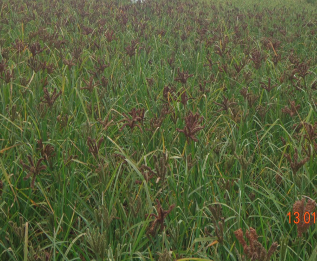
- Finger millet is a nutritious traditional cereal largely grown by small scale farmers in Kenya. It is an important subsistence and food security crop, especially important for its nutritive and cultural value.
- Has no storage pests due to small grain size.
- Food uses of the crop include: “uji”; “ugali”, bread and other products.
- Popped products include malt and beverages (beer).
- Finger millet cannot tolerate flooding.
- Finger millet will produce 2.5 metric tons per hectare with a good variety under good management.
-
Finger millet will produce 2.5 metric tons per hectare with a good variety under good management.
Recommended varieties
Select varieties adapted to your agro-ecological zones and special traits like blast disease, Striga weed, and lodge resistance.

- High yielding (1.1 – 4.9 metric tons per ha-1 depending on environment);
- Resistant - to Blast disease, Striga weed, and lodging;
- Tolerant to drought.
- Adapted to low and medium altitudes upto 1,500 meters above sea level with R/F of 600-900mm annually.
- Has purple pigmentation and fist heads
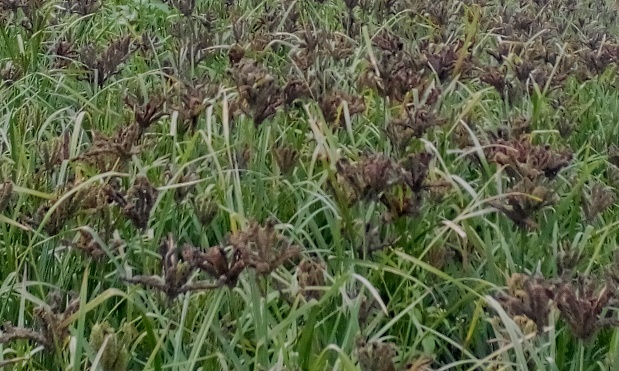
- Late maturing (88 – 138 days).
- High yielding (1.14 – 6.67 metric tons per ha-1 depending on environment).
- Resistant to blast disease, Striga weed, and lodging.
- Tolerant to drought.
- Has wide adaptability - can grow upto 2,500 meters above sea level with R/F of 600-900mm annually.
- Has purple pigmentation, thick stem, and large open heads.
Kak-Wimbi 4
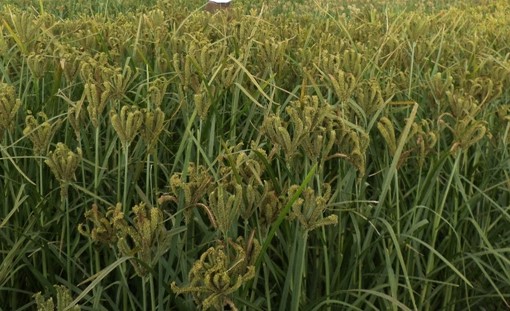
- Late maturing (87 – 130 days);
- High yielding (1.4 – 5.5 metric tons depending on environment);
- Resistant to Striga weed and lodging.
- Tolerant to blast disease and drought.
- Has wide adaptability and can grow up to 2,500 meters above sea level and R/F of 600-900mm annually.
- Has large open incurved heads.
P-224
- Medium in maturity (95 – 125 days);
- High yielding (1.2 - 4.9 metric tons depending on environment);
- Moderately susceptible to blast disease and susceptible to Striga weed;
- Prone to post maturity lodging;
- Has wide adaptability and can grow up to 2,500 meters above sea level and R/F of 600-900mm annually;
- Has large open heads with prominent grains.
Kak-Wimbi 5 (KACIMMI 49)
- Medium in maturity (86 - 135 days).
- High yielding (1.25 - 5.68 metric tons per hectare depending on environment).
- Tolerant to Striga weed, blast disease and drought.
- Well adapted to low to medium altitudes up to 2,000 meters above sea level and R/F of 600-900mm annually.
- Has medium size twisted finger heads
Kak-Wimbi 6 (KACIMMI 65)

- Early maturing (87 – 118 days).
- High yielding variety (1.34 – 4.01 metric tons per hectare depending on environment).
- Resistant to blast disease, Striga weed, and lodging.
- Tolerant to drought.
- Well adapted to low to medium altitudes up to 2,000 meters above sea level and R/F of 600-900mm annually.
- Has medium size and open heads.
Nakuru FM-1
- Late maturing (120 – 210 days).
- High yielding (1.2 - 3.5 metric tons per hectare depending on environment).
- Tolerant to cold and drought.
- Well adapted to cool highlands and can grow up to 2,500 meters above sea level and R/F of 600-900mm annually;
- It has purple pigmentation and medium to large size open heads.
KAT FM 1

- Early maturing (80 – 115 days);
- Moderate yield (1.0 – 2.5 metric tons per hectare depending on environment);
- Drought tolerant.
- Susceptible to blast disease and prone to post maturity lodging.
- Well adapted to low altitude dry environments up to 1,200 meters above sea level and R/F of 400-700mm annually.
- It has medium to large open heads.
MSU FM 60D
- Early maturing (80-90 days).
- Moderate yield (average 3.12metric tons per hectare).
- Drought tolerant.
- Susceptible to blast disease and prone to post maturity lodging.
- Well adapted to low altitude dry environments up to 1,500 meters above sea level and R/F of 400-700mm annually.
- It has medium to large open heads.
EUFM-401
- Very early maturing (65-75 days).
- Moderate yield (1.0 – 1.40 metric tons per hectare depending on environment).
- Drought tolerant/ escaping.
- Well adapted to low altitude dry environments up to 1,500 meters above sea level and R/F of 400-600mm annually;
- It is heat tolerant.
EUFM-502
- Medium maturing (100-120 days).
- Moderate yield (1.4 – 2.0 metric tons per hectare depending on environment).
- Well adapted to medium to high altitude environments up to 2,200 meters above sea level and R/F of 500-700mm annuall
- Has high tillering capacity.
EUFM-503
- Medium maturing (90-98 days).
- Moderate yield (1.5 – 2.5 metric tons per hectare depending on environment).
- Resistant to blast disease.
- Well adapted to medium to high altitude environments up to 2,200 meters above sea level and R/F of 500-700mm annually.
- Has high tillering capacity
Kis-Wimbi 1
- Very Early maturing (81 - 100 days).
- High yielding (1.1 - 4.27 metric tons per hectare depending on environment).
- Resistant to blast disease, Striga weed, and lodging.
- Drought tolerant / escaping.
- Adapted to low and medium altitudes up to 1,500 meters above sea level with R/F of 600-900mm annually.
- Has large whitish heads with a prominent branching thumb finger
GBK 043254
-
A high yielding, early maturing, finger millet variety
- Striga resistant, Blast and Drought tolerant
- Whitish Brown grain color; light purple pigmentation; medium height; medium size open panicles with finger spikelet discontinuity.
- Optimal environmental conditions: Rainfall (600-900mm annually), altitude (0 – 2,000 m.a.s.l.) and soils (well-draining loams).
- Whitish brown grain color; no pigmentation; medium height; medium size open panicles with gapy spikes
Agro-ecological requirements
It is a long to medium day length plant with optimal photo period of 12 hours.
Rainfall: Finger Millet grows well under moderate rainfall of 500-1000 mm annually. With good distribution, Finger millet can tolerate rainfall as low as 130mm; but performs best at 900mm.
Temperature: Finger millet grows best where average maximum temperatures exceed 27°C and the average minimum do not fall below 18°C, but can grow in temperatures as high as 35°C.
Altitude: Most of the world's finger millet is grown at intermediate elevations, between 500 and 2,400 m a.s.l., but the crop can grow from sea-level to over 2,400 m.a.s.l.
Soils: Finger millet can grow on a variety of soils, but does well on well-drained silt loam soils - reddish brown earth, calcic red yellow latasols and sandy regosol
- Clear land early during dry season. Do 1st and 2nd ploughing at an interval of 1 week.
- One week after 2nd ploughing do 1st and 2nd harrowing also at an interval of 1 week
- Plough land with appropriate equipment. A jembe (hoe) can be used or, if possible, mechanize by using a power tiller or oxen drawn implements.
- Contour farming technique is recommended
Pre-planting
Seeds and fertilizers should be obtained from reliable sources. In the absence of certified seed, farmer saved seeds are alternatives
Planting Finger Millet
- Plant at the start of the seasonal rains by opening shallow furrows (5cm deep) spaced 30cm (1ft.) apart.
- In furrows apply basal compound NPK 20:20:0 fertilizer (one 50 kg bag/acre).
- A handful of fertilizer should cover 10 steps (10m) along the furrow.
- Drill very little seed at a rate of 1 kg/acre uniformly in each furrow.
- A handful of seed is adequate to plant 100 steps (100m) along the furrow.
- Cover the furrows with loose soil

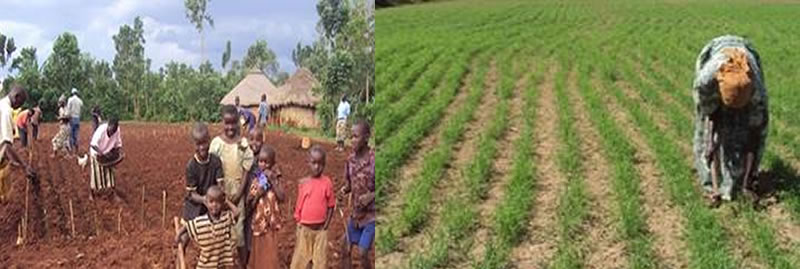
Integrated Soil Fertility Management (ISFM) -Fertilizer in finger millet cultivation
ISFM is a set of soil fertility management practices that include the use of fertilizers, manure and improved seed combined to adapt practices to local conditions.
- Applying fertilizer on finger millet doubles yield.
- Fertilizer rates: 100kg per hectare 20:20:0 NPK at planting and 100kg ha-1 CAN at top-dressing after first weeding.
- Also practice soil erosion control and Water harvesting (SEWHA) to conserve soil fertility for sustainable productivity of finger millet crop.

Weeding, thinning gapping, and top Dressing
- First Weeding two weeks after crop emergence.
- After the first weeding, thin (reduce) and gap (fill gaps) within the row to approximately 15cm (½ft.) from plant to plant when soil is wet.
- After thinning and when soils are moist, apply top dress fertilizer (50kg bag/acre CAN) thinly along and close to the upper slope side of the row.
- Do second weeding two weeks after first weeding or when weeds appear to compete the crop.
- Subsequently keep fields weed free



Finger millet insect pests
- Cutworms
- Chafer grubs
- Stem borers
- Shoot fly
- Midge
- Army-worms
- Nematodes
Army worm

Aphids
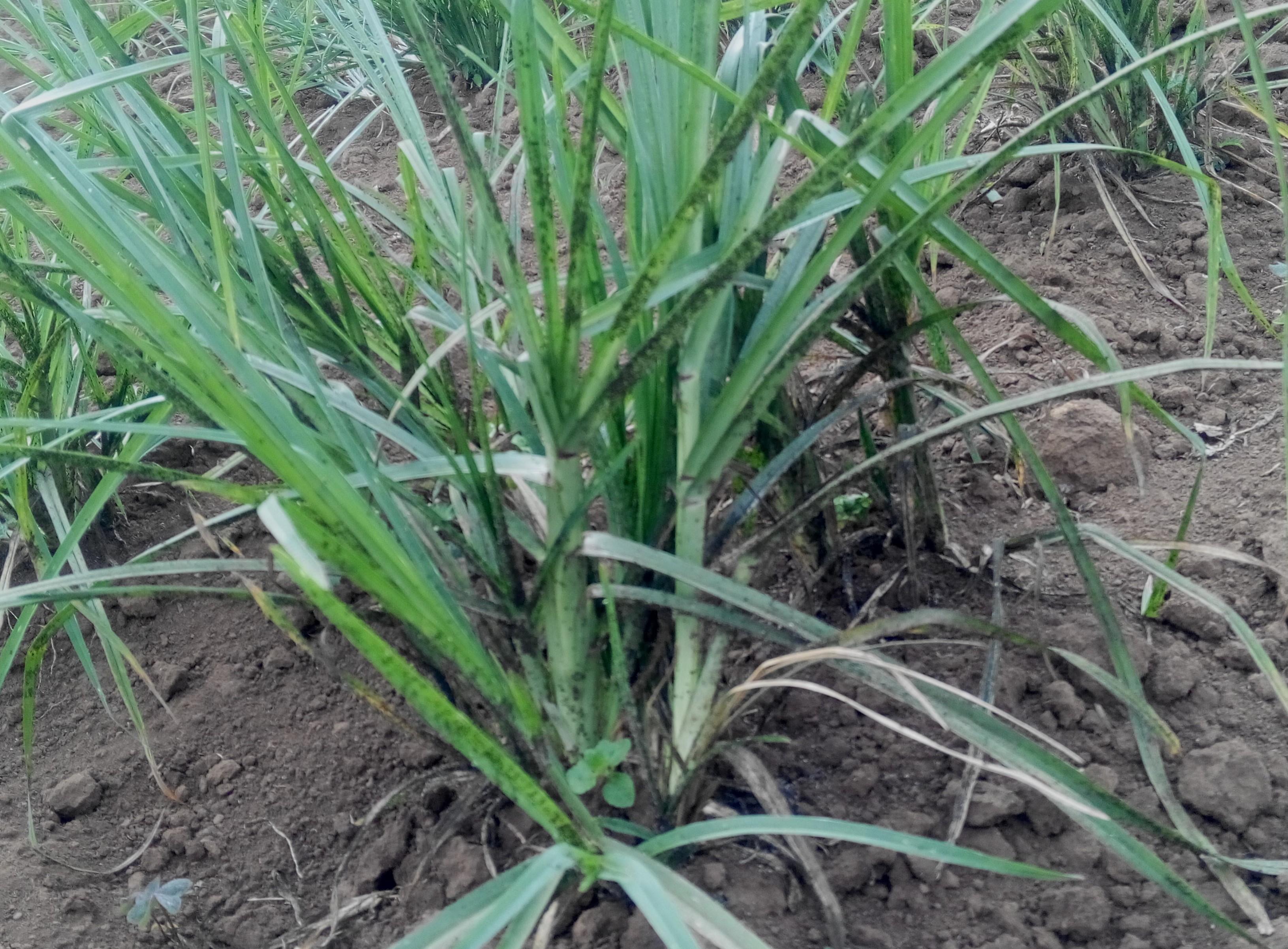
Plant parasite pest
Finger millet diseases
Blast disease - most important.

- Wilt or Foot Rot
- Leaf Spot
- Downy Mildew or Green Ear Disease
- Finger millet Smut
- Damping Off
- Damping Off
- Bacterial blight and leaf spot
- Viral diseases: mottle streak, sugarcane mosaic, and streak.
- Pests and disease management strategies fall under Integrated Pest and Disease Management (IPDSM) that consists of various methods practiced wholly or in partial combinations.
The methods are in various categories:
- Cultural e.g sanitation, tillage, Intercropping, weed Control.
- Mechanical e.g. collection and destruction
- Physical - e.g. setting up of light traps
- Host Plant Resistance (HPR) e.g. resistant varieties
- Chemical Control - involves use of contact, gut, or systemic chemicals.
- Biological Control.
- For important insect pests of finger millet, chemicals are commonly used according to manufacturer specifications.
Striga is controlled through HPR, mechanical, and cultural methods; blast disease is mainly managed through HPR; and birds through physical, mechanical, and HPR.
Integrated Soil Fertility Management (ISFM) -Fertilizer in finger millet cultivation
ISFM is a set of soil fertility management practices that include the use of fertilizers, manure and improved seed combined to adapt practices to local conditions.
- Applying fertilizer on finger millet doubles yield.
- Fertilizer rates: 100kg per hactare 20:20:0 NPK at planting and 100kg ha-1 CAN at top-dressing after first weeding.
- Also practice soil erosion control and Water harvesting (SEWHA) to conserve soil fertility for sustainable productivity of finger millet crop.

Weeding, thinning gapping, and top Dressing
- First Weeding two weeks after crop emergence.
- After the first weeding, thin (reduce) and gap (fill gaps) within the row to approximately 15cm (½ft.) from plant to plant when soil is wet.
- After thinning and when soils are moist, apply top dress fertilizer (50kg bag/acre CAN) thinly along and close to the upper slope side of the row.
- Do second weeding two weeks after first weeding or when weeds appear to compete the crop.
- Subsequently keep fields weed free

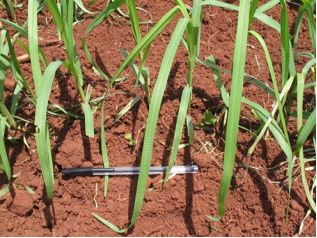

- Finger Millet can easily shatter if harvesting is delayed after physiological maturity.
- This can lead to up to 15 % losses depending on variety.
- Birds can also cause significant losses.
- Keenly monitor grains on head for physiological maturity.
- Physiological maturity - when a pinch of grain does not crush into milky substance when rubbed between thumb and fore-finger.
- Harvest by cutting off the heads using a billhook knife or any appropriate tool.
- Transport the harvest in pore less or tiny pore containers to homestead or dryer for drying to avoid losing grain that rubs off the heads.

Post-Harvest
This is a stage of crop production after harvest, including drying, threshing, winnowing/cleaning, packing, storage etc. It determines the quality of grain.
- Postharvest loss =degradation in both quantity and quality of grain from harvest to consumption.
- Quality losses affect nutrient content, acceptability, and edibility.
- Stages of post-harvest management

- To reduce spillage, contamination, germination, spoilage, and pests use grain dryer if available.
- Sun drying on clean surface like a cement slab or canvas
- Spread and turn frequently.
- Dry for 4 – 5 days to 12% moisture content and recover all grain.

At Threshing
-
Target is to extract clean grain from heads and glume:
-
Achieved through use of a thresher if available but can also winnow by pounding on clean surface like canvas.
-
Avoid pounding on hard surface to avoid grain breakage; avoid pounding on bare ground to avoid grit.

JKUAT/ Egerton University developed thresher

KALRO AMRI developed thesher
Winnowing

Transportation
- Target is to deliver dry grain without spillage, seepage, and spoilage.
- Achieved through right packaging and handling to minimize losses
- Maintain hygiene in carriages; use air-tight, cool, and dry carriers.

in Storage
- Target is short, medium, to long term storage without compromised quantity and quality.
- Achieved through use of traditional well ventilated and kept granaries or tightly closed containers kept in cool, dark and dry rooms e.g Hermetic storage bags/silos (PICS, AgroZ, ZeroFly, Elites, Metal Silos or Plastic Silos).
- Avoid use of pesticides during storage.
- Finger millet grain can stay un spoilt for up to 20 years.
Crop value-addition
- This are processes that increase the value of crop products by increasing consumer appeal and demand hence prices and revenue base for the producers.
Finger Millet Ugali

Uji (porridge)
A highly nutritious, non-glutinous and none acid forming food

Finger Millet Crackie
- A dry snack made from finger millet, sweet potato, spices and wheat flour

TAMUU Paste Food Product
A paste food product that can be used as bread spread or consumed directly.

Finger Millet Onion Bites
A snack made from finger millet, sweet potato, wheat flour and onions.

Finger Millet Cake
-made from a finger millet – wheat flour composite.

Finger Millet Chapatti
A main meal made from a finger millet – wheat flour composite.

Finger Millet Mandazi
-A snack made from a finger millet – wheat flour blend.

Finger Millet Blended and Composite Flour
Flours made from finger millet – wheat, cassava, or maize flour composites.

Finger Millet Biscuit
-Snack made from finger millet – wheat flour composite.

Agricultural mechanization is a process that replaces human labor along an agricultural value chain by other sources of energy like animal power, fuel, or renewable energy (Malabo Montpellier Panel Report, 2019). A number of machines can be applied at various nodes of finger millet value chain.
- Tractor or animal drawn and can be used. for clods after ploughing.
- Stir soil, uproot weeds, level ground, and cover seeds after planting.

Shallow weeder (hoe)
- Used to dig land, shape soil, remove weeds, and clear soil.

Seed drill
- Used to drill or apply seed and fertilizer at planting at predetermined quantities. Either tractor or animal drawn depending on size

Knapsack Motorized Mist Blower Cum Duster
- An engine driven, and carried on operator back sprayer for spray needs e.g. spraying insecticides against insect pests or foliar fertilizer.

Gasoline Tiller Cultivator Weeder
A small multi-purpose machine for small fields. It has options for tilling, weeding, cutting etc.

- Finger millet demand is high and increasing in Kenya because of recognized nutritional and diet for diabetics, infants, expectant mothers, patients, and as well as for cultural and social functions e.g. weddings and circumcision ceremonies.
- It is mainly traded locally - farmers sell to local traders in the local markets.
- Some farmers add value (malting, brewing, and processing into snacks such as crackies).
- Finger millet stover and by products of processing may also be sold to supplement incomes.
- Local traders usually aggregate their purchased grain and supply urban traders or processors.
Revenue
Yield per acre 11 x 90kg bags
11x90-kg bags @ KES.75 per kg
Total Revenue: 74,250/=
Business Costs and Revenue per acre of Finger millet (KES)
Seeds 2 kg @ 350 per acre 360
Land preparation (ox plough) 6,000
Planting cost (10 mandays x 300) 2,500
Fertilizer (basal & top dressing,
1 bag each) 6,000
Weeding twice & thinning
(30 mandays) 9,000
Harvesting & airing (4 Mandays
x 5 days x 300) 6,000
Threshing & winnowing
(10 mandays) 3,000
Transport 800
Miscellaneous costs 1,000
Total cost 34,660
Gross margin/acre
(Revenue – Cost) 39,590

Further reading
Central Planning and Project Monitoring Unit, (2015), Economic Review of Agriculture (ERA), pp. 104, Ministry of Agriculture, Nairobi.
Keatinge J., Easdown W., Yang R., Chadha M. and Shanmugasundaram S. (2011). Overcoming chronic malnutrition in a future warming world: the key importance of Finger millet and vegetable soybean. Euphytica 180, 129-141.
Malabo Montpellier Panel Report, 2019. Platform for African European Partnership in Agricultural Research for Development. PAEPARD, EU, FARA.
Oduori C.O.A. 2018. Finger Millet Variety P-224. Leaflet funded by the McKnight Foundation CCRP EAF CoP Finger Millet Improvement Project. Kenya Agricultural and Livestock Research Organization
Contacts
Kenya Agricultural and Livestock Research Organization
P.O. Box 57811-00200, Nairobi, Kenya
Call: 0111010100